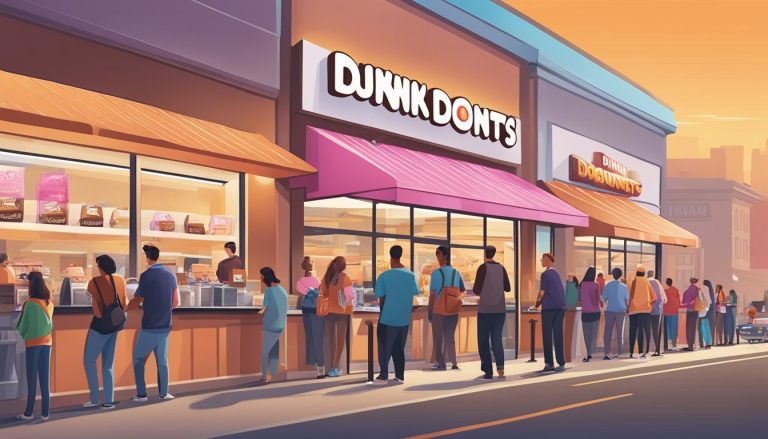Dunkin’ Donuts has transformed from a local Massachusetts coffee shop into a global powerhouse, with over 11,300 locations across 26 countries. The brand’s international expansion strategy focuses on adapting its offerings to local tastes while maintaining its core identity. Dunkin’ successfully navigates cultural differences by tailoring its menu and marketing to each new market, ensuring relevance and appeal to diverse consumer bases.
This approach has allowed Dunkin’ to thrive in vastly different markets, from Asia to Europe and the Middle East. The company’s willingness to innovate and adjust its products has been crucial to its global success. For instance, in India, Dunkin’ offers spicy sandwiches and tea alongside its traditional coffee and donuts, catering to local preferences.
Dunkin’s international journey, spanning over 70 years, demonstrates the power of localization in building a global brand. By understanding and embracing cultural nuances, Dunkin’ has established itself as a familiar and beloved presence in numerous countries, proving that a local favorite can indeed become a worldwide sensation.
Dunkin’s Global Expansion Strategy

Dunkin’ has implemented a multi-faceted approach to expand internationally. The company relies heavily on franchising to fuel its global growth. This model allows for rapid expansion while leveraging local partners’ market knowledge.
Market research plays a crucial role in Dunkin’s strategy. The company carefully studies consumer preferences, cultural norms, and competitive landscapes before entering new markets.
Dunkin’ adapts its menu and marketing to suit local tastes. In India, for example, the chain offers spicy donuts and coffee flavored with cardamom to appeal to local palates.
Strategic partnerships form another key component of Dunkin’s global strategy. The company often collaborates with established local businesses to navigate regulatory challenges and gain market insights.
Dunkin’ focuses on maintaining brand consistency while allowing for regional flexibility. This approach helps create a recognizable global brand while catering to diverse consumer needs.
The company’s competitive advantage stems from its ability to offer affordable, quality products tailored to local preferences. This strategy has enabled Dunkin’ to successfully compete against both local and international rivals in various markets.
Dunkin’ currently operates in 26 countries, with over 11,300 international locations. The company continues to target high-growth markets, particularly in Asia and the Middle East, for future expansion.
Innovating the Breakfast Experience

Dunkin’ has revolutionized the global breakfast scene through strategic menu adaptations and culinary innovations tailored to local tastes. This approach has positioned the brand as a leader in breakfast offerings worldwide.
Menu Innovation for Local Tastes
Dunkin’ excels at localizing its menu to suit diverse cultural preferences. In India, the brand introduced the Tough Guy Burger, featuring a spicy chicken patty. For the Korean market, Dunkin’ created the Grapefruit Coolatta, a refreshing drink that appeals to local palates.
The company also adapts its classic offerings. In China, Dunkin’ serves Dry Pork and Seaweed donuts. These unique flavors demonstrate Dunkin’s commitment to embracing local tastes while maintaining its core identity.
Dunkin’ regularly conducts market research to identify regional flavor preferences. This data-driven approach ensures that new menu items resonate with local customers.
Culinary Innovation and Product Range
Dunkin’ continually expands its product range to meet evolving consumer demands. The brand has moved beyond traditional donuts and coffee to offer a wide array of breakfast options.
Sandwich innovations include the Beyond Sausage Breakfast Sandwich, catering to the growing plant-based market. Dunkin’ also introduced the Power Breakfast Sandwich, targeting health-conscious consumers.
In the beverage category, Dunkin’ has launched specialty coffee drinks like the Caramel Chocoholic Donut Latte. These creative concoctions blend familiar flavors with new taste experiences.
Dunkin’ invests in culinary research and development to stay ahead of food trends. This commitment to innovation ensures that the brand remains relevant in the competitive global breakfast market.
Leveraging Technology for Customer Engagement

Dunkin’ has embraced digital tools to enhance customer interactions and streamline ordering processes. The company’s tech-focused approach aims to boost convenience and foster brand loyalty in international markets.
Digital Marketing and Social Media
Dunkin’ utilizes social media platforms to connect with customers globally. The brand maintains active presences on Instagram, Twitter, and Facebook, tailoring content to local preferences. These channels serve as hubs for promotions, product launches, and customer engagement.
Influencer partnerships play a key role in Dunkin’s digital strategy. Collaborations with local celebrities and social media personalities help the brand resonate with diverse audiences. These partnerships often result in increased brand awareness and sales.
Dunkin’ also employs targeted digital advertising campaigns. Geolocation technology allows the company to deliver personalized offers to customers near their stores, driving foot traffic and sales.
Mobile App & On-The-Go Ordering
The Dunkin’ mobile app stands as a cornerstone of the brand’s technology strategy. Available in multiple languages, the app offers features like store locators, menu browsing, and nutritional information.
On-The-Go ordering is a standout feature, allowing customers to place orders in advance for quick pickup. This function reduces wait times and enhances convenience, particularly in busy urban markets.
The DD Perks Rewards Program, integrated into the app, incentivizes repeat purchases. Members earn points on every purchase, redeemable for free beverages. This digital loyalty program helps Dunkin’ gather valuable customer data and tailor offerings to individual preferences.
The Power of Branding and Rebranding
Dunkin’s success in global expansion is closely tied to its effective branding strategies. The company’s visual identity and logo have played crucial roles in establishing brand recognition worldwide. A significant rebranding effort in 2018 further solidified Dunkin’s position as a beverage-focused chain.
Visual Identity and the Logo
Dunkin’s iconic pink and orange color scheme has become instantly recognizable across the globe. These vibrant hues evoke a sense of energy and warmth, aligning with the brand’s promise of quick service and comforting treats. The logo’s evolution has been subtle yet impactful, maintaining familiar elements while adapting to modern design trends.
The simplified logo design enhances visibility and recall, crucial for a brand operating in diverse international markets. This visual consistency across countries helps build brand loyalty, as customers can easily spot a Dunkin’ location regardless of their geographic location.
Rebranding to Dunkin’
In 2018, Dunkin’ Donuts made a bold move by dropping “Donuts” from its name. This strategic rebranding aimed to position the company as a beverage-focused brand, reflecting its expanded menu offerings beyond donuts. The shortened name “Dunkin'” is more versatile and easier to market across different cultures and languages.
The rebranding effort signaled Dunkin’s commitment to evolving with changing consumer preferences. It allowed the company to highlight its coffee and beverage options, appealing to a broader customer base. This shift in brand identity has supported Dunkin’s global expansion efforts, particularly in markets where coffee culture is prominent.
By simplifying its name, Dunkin’ created a more flexible brand identity that can adapt to diverse international markets while maintaining its core values and recognition.
Customer Centric Approach
Dunkin’ prioritizes understanding and meeting customer needs across diverse global markets. The company employs targeted strategies to build loyalty and enhance the customer experience.
Understanding Consumer Preferences
Dunkin’ tailors its menu offerings to align with local tastes and cultural preferences. In India, they introduced vegetarian options and spicy donuts. The Japanese market saw the introduction of matcha-flavored items. Dunkin’ regularly conducts market research and gathers customer feedback to refine its product lineup.
The company also adapts its store designs and service models to match regional expectations. In some Asian markets, Dunkin’ locations feature more upscale interiors and table service to cater to local dining habits.
Rewards & Loyalty Programs
Dunkin’ leverages technology to enhance customer loyalty. The DD Perks program allows customers to earn points on purchases, redeemable for free items. Members receive personalized offers based on their buying habits.
The Dunkin’ mobile app streamlines ordering and payment processes. It offers features like mobile ordering and contactless pickup, improving convenience for busy customers.
Dunkin’ also runs targeted promotions, such as “Free Donut Fridays” for DD Perks members, to drive repeat visits and increase customer engagement.
Comprehensive Market Integration

Dunkin’ has successfully integrated into diverse global markets by adapting to local demands and optimizing its supply chain. This approach has allowed the company to expand its market share while maintaining affordability and quality across regions.
Adapting to Market Demands
Dunkin’ tailors its menu to suit local tastes and preferences in each market. In India, the company offers spicy sandwiches and vegetarian options. South Korean outlets feature bubble tea and glazed sweet potato donuts. This localization strategy helps Dunkin’ compete with local brands and attract a wider customer base.
The franchise model allows local operators to provide input on menu items and marketing strategies. This ensures that Dunkin’ remains relevant and appealing to local consumers. The company also adjusts pricing to match local economic conditions, maintaining affordability in different markets.
Supply Chain and Diversification
Dunkin’ has developed a robust global supply chain to support its international expansion. The company partners with local suppliers to source ingredients, reducing costs and ensuring freshness. This approach also helps Dunkin’ comply with local regulations and support local economies.
To mitigate risks, Dunkin’ diversifies its product offerings beyond donuts and coffee. The company has introduced breakfast sandwiches, wraps, and other food items to appeal to a broader customer base. This diversification strategy helps Dunkin’ compete in the quick-service restaurant sector and reduces dependence on any single product line.
Competitor Analysis and Market Positioning

Dunkin’ faces stiff competition in the global breakfast and coffee market, particularly from Starbucks and Tim Hortons. The brand has positioned itself as a quick-service option, emphasizing speed and affordability.
Navigating Competition with Starbucks and Tim Hortons
Starbucks remains Dunkin’s primary global competitor, with a larger international presence and a more premium brand image. Dunkin’ differentiates itself by focusing on faster service and lower prices. In Canada and select international markets, Tim Hortons presents another strong rival. Dunkin’ counters by highlighting its wider menu variety and American brand appeal.
To gain market share, Dunkin’ has adapted its offerings to local tastes while maintaining core products. This strategy has helped the brand compete effectively in diverse markets against both global and local competitors.
Positioning as a Quick Service Brand
Dunkin’ has firmly established itself in the fast-food industry as a quick service restaurant (QSR) specializing in breakfast and coffee. This positioning sets it apart from Starbucks’ café-style approach and aligns more closely with McDonald’s breakfast segment.
The brand emphasizes:
- Speed of service
- Affordability
- Convenient locations
- Consistent quality
By focusing on these attributes, Dunkin’ has carved out a distinct competitive advantage in the breakfast segment of the QSR market. Its streamlined menu and efficient operations allow for faster turnover, appealing to time-pressed consumers.
The Journey of Dunkin’

Dunkin’ has transformed from a local coffee shop to a global breakfast powerhouse. Its journey spans decades of growth, innovation, and strategic expansion across international markets.
Founding and History
William Rosenberg founded Open Kettle in 1948, selling donuts and coffee in Quincy, Massachusetts. He renamed it Dunkin’ Donuts in 1950, focusing on quality products and customer service. The first franchise opened in 1955, marking the beginning of rapid expansion.
By 1963, Dunkin’ Donuts had 100 locations. The company introduced its iconic Munchkins donut holes in 1972, diversifying its menu. Throughout the 1970s and 1980s, Dunkin’ continued to grow domestically and ventured into international markets.
Evolution into Dunkin’ Brands
Dunkin’ Donuts merged with Baskin-Robbins ice cream in 1990, forming Allied Domecq Quick Service Restaurants. This merger expanded the company’s product range and global reach.
In 2004, the company was acquired by a consortium of private equity firms. It was renamed Dunkin’ Brands Group in 2006, overseeing both Dunkin’ Donuts and Baskin-Robbins chains.
Dunkin’ Brands went public in 2011. The company rebranded as simply “Dunkin'” in 2019, reflecting its expanded menu beyond donuts. Today, Dunkin’ operates over 11,300 locations across 26 countries, adapting its offerings to local tastes while maintaining its core identity.




